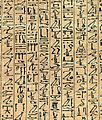Book of the Dead facts for kids
The Book of the Dead is an important ancient Egyptian text. It's also known as The Book of Coming Forth By Day. This name describes its main goal: to help a dead person travel safely into the afterlife.
This special book was usually written on a long papyrus scroll. It was often placed inside the coffin of the person who died, or in their burial room. The most famous versions of the Book of the Dead appeared during Egypt's New Kingdom period. However, many of the spells and writings in it came from even older texts. These older texts were used in funerals during the Old and Middle Kingdoms.
Contents
What is the Book of the Dead?
The Book of the Dead is a collection of texts and spells. Ancient Egyptians believed these spells would guide and protect the deceased. They thought it would help them reach the afterlife safely. It was like a guidebook for the journey after death.
Why was it important to ancient Egyptians?
Ancient Egyptians believed in a journey after death. They thought the soul needed help to pass through dangers. The Book of the Dead provided this help. It contained prayers, spells, and instructions. These were meant to help the dead person overcome challenges. It also helped them prove they lived a good life.
How was the book made?
Most copies of the Book of the Dead were written on papyrus scrolls. Papyrus was a thick paper-like material. It was made from the papyrus plant. Sometimes, parts of the book were also written on tomb walls or coffins. The texts were often decorated with colorful pictures. These pictures showed scenes from the afterlife journey.
Who named the Book of the Dead?
The name "Book of the Dead" was not given by the ancient Egyptians. A German expert named Karl Richard Lepsius created this name. He was an Egyptologist, someone who studies ancient Egypt. Lepsius published some of these texts in 1842. He called them the "Book of the Dead."
Recent Discoveries
In 2012, some missing parts of the Book of the Dead were found. They were discovered in the Queensland Museum. Historians hoped these new pieces would help them complete a full copy of the book. This shows that even today, we are still learning about ancient Egypt.
Images for kids
-
This picture from the Papyrus of Hunefer (around 1275 BCE) shows a heart being weighed. The jackal-headed god Anubis weighs Hunefer's heart against the feather of truth. The ibis-headed god Thoth writes down the result. If the heart is as light as the feather, Hunefer can enter the afterlife. If not, a creature called Ammit (part crocodile, lion, and hippopotamus) eats it. Pictures like this were common in Egyptian Books of the Dead.
-
This is part of the Pyramid Texts. These were older writings that came before the Book of the Dead. They are carved on the tomb of Teti.
-
This is Spell 17 from the Papyrus of Ani. The picture at the top shows different gods and symbols. From left to right, you can see the god Heh (representing the Sea), a gate to the land of Osiris, the Eye of Horus, the sky cow Mehet-Weret, and a human head rising from a coffin, protected by the four Sons of Horus.
See also
 In Spanish: Libro de los muertos para niños
In Spanish: Libro de los muertos para niños









